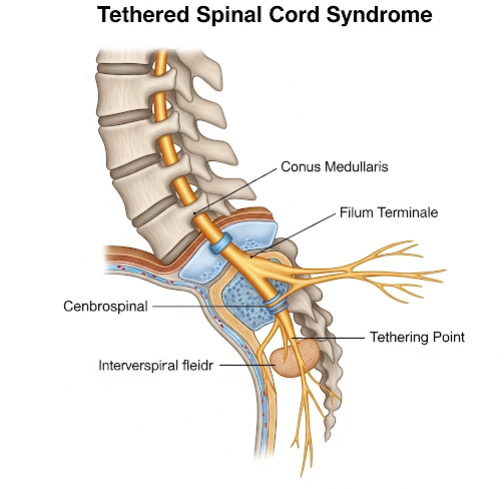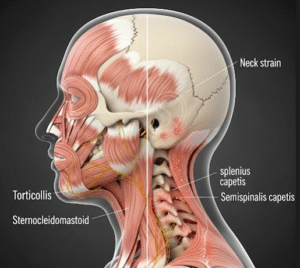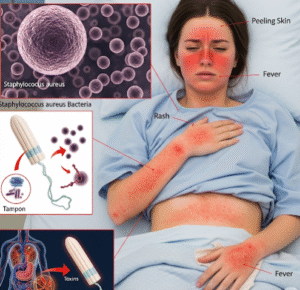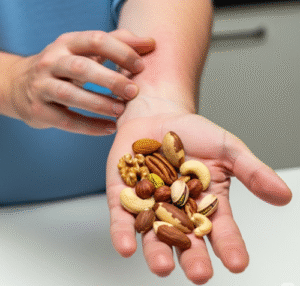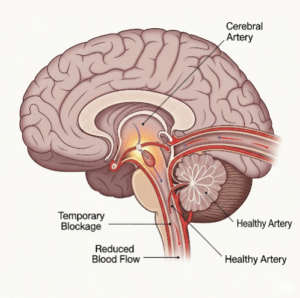Overview
Tethered Spinal Cord Syndrome (TSCS) is a neurological disorder in which the spinal cord is abnormally attached or “tethered” to surrounding tissues, limiting its normal movement within the spinal column. This tension can stretch the spinal cord, causing progressive neurological symptoms. TSCS can be congenital—present at birth—or acquired later due to trauma, surgery, or tumors. In Korea, advanced neurosurgical care, high-resolution imaging, and rehabilitation programs are available to diagnose and treat TSCS effectively, aiming to prevent permanent nerve damage and improve patient quality of life.
What is Tethered Spinal Cord Syndrome?
TSCS occurs when the spinal cord is anchored to tissues such as fibrous bands, fatty deposits, scar tissue, or bony anomalies. This abnormal attachment restricts the spinal cord’s movement, particularly as a child grows or after spinal injury. Normally, the spinal cord floats freely within the spinal canal, adjusting during growth and movement. In TSCS, tethering can lead to stretching and damage of nerve fibers, resulting in neurological and functional impairments.
Symptoms
Symptoms of Tethered Spinal Cord Syndrome can vary based on the severity, age of onset, and location of tethering. Common signs include:
- Pain or stiffness in the lower back
- Leg weakness, numbness, or tingling
- Difficulty walking or abnormal gait
- Loss of bladder or bowel control
- Scoliosis or other spinal deformities
- Muscle spasms or abnormal reflexes
- Fatigue or discomfort with prolonged standing or activity
In infants and young children, subtle signs may include delayed motor milestones, foot deformities, or unusual skin markings on the lower back. Adults may develop progressive neurological deficits if untreated.
Causes
TSCS can arise from several causes:
- Congenital malformations: Spina bifida, lipomyelomeningocele, and other spinal dysraphisms are common congenital causes.
- Scar tissue or adhesions: Post-surgical or post-traumatic scarring may tether the spinal cord.
- Lipomas or fatty tumors: Fat deposits can attach to the spinal cord, creating tension.
- Trauma: Injuries to the spine may result in acquired tethering.
- Spinal tumors: Rarely, tumors can anchor the spinal cord.
Risk Factors
Factors that increase the likelihood of TSCS include:
- Congenital spinal defects: Children born with spina bifida or similar conditions
- Previous spinal surgery or trauma: Scar tissue can tether the cord
- Rapid growth periods: Symptoms often become apparent during childhood growth spurts
- Genetic predisposition: Some congenital spinal anomalies have hereditary links
Complications
Untreated TSCS can lead to serious, long-term complications:
- Progressive paralysis or weakness in the legs
- Permanent bladder or bowel dysfunction
- Chronic back pain and mobility limitations
- Scoliosis and spinal deformities
- Sensory deficits in the lower extremities
- Muscle atrophy due to prolonged nerve tension
- Reduced quality of life from chronic disability
Prevention
While congenital TSCS cannot always be prevented, early detection and proactive management can reduce complications:
- Prenatal ultrasounds to identify spinal abnormalities
- Early screening for children with congenital spinal defects
- Prompt evaluation for unexplained lower back pain, leg weakness, or bladder issues
- Careful surgical techniques to minimize scarring after spinal procedures
- Genetic counseling for families with a history of congenital spinal conditions
Treatment Options in Korea
Korea offers advanced diagnostic and treatment options for TSCS, focusing on preserving neurological function and improving quality of life:
1. Diagnostic Evaluation
- MRI scans: The primary tool to detect tethering and associated spinal anomalies
- CT scans and X-rays: Assess bone structures and deformities
- Urodynamic studies: Evaluate bladder function in affected patients
- Neurological assessments: Measure motor and sensory deficits
2. Surgical Treatment
- Detethering surgery: Surgical release of the spinal cord from adhesions, lipomas, or other tethering structures.
- Minimally invasive techniques: Reduce tissue damage and recovery time in selected cases.
- Spinal stabilization procedures: May be combined with detethering for scoliosis or spinal instability.
3. Postoperative Care and Rehabilitation
- Physical therapy to restore mobility, strength, and gait
- Occupational therapy for daily activity assistance
- Bladder and bowel management programs
- Regular follow-up imaging to monitor for recurrence
- Pain management and supportive care as needed
4. Cost and Hospital Care
Treatment costs in Korea vary based on surgery complexity and hospitalization duration. Leading neurosurgical centers provide multidisciplinary care, advanced imaging, and modern operating facilities. Early intervention improves neurological recovery, minimizes long-term disability, and enhances overall quality of life for patients with TSCS.

